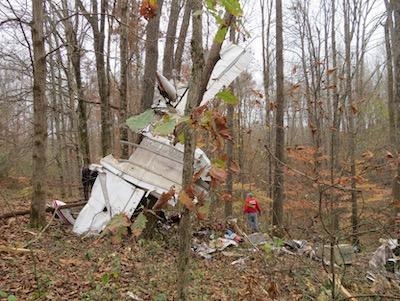Cites Flight Into Instrument Conditions By A Non-Instrument-Rated Pilot
On November 12, 2017, at 1410 central standard time, a Piper PA-32-260 Cherokee was destroyed during an in-flight breakup and collision with terrain while maneuvering near Fountain Run, KY. The private pilot and three passengers were fatally injured. The airplane was owned and operated by the pilot.

No flight plan was filed for the personal flight, which departed Everett-Stewart Regional Airport (KUCY), Union City, TN, at 1303 local time en route to Lake Cumberland Regional Airport (KSME), Somerset, KY.
According to the report, the noninstrument-rated private pilot did not obtain an official weather briefing or file a flight plan before departing on the cross-country flight with three passengers. About 55 minutes into the flight, while cruising at 5,500 ft and receiving visual flight rules (VFR) flight following services from air traffic control, the pilot advised the controller that he was climbing the airplane to "maintain VFR." Six minutes later, after completing a series of erratic turns between 6,600 and 7,200 ft, the pilot advised the controller that he had encountered instrument meteorological conditions (IMC) and requested vectors to an altitude with "more visibility." The controller advised that the cloud tops were reported about 8,000 ft, and the pilot stated that he would climb the airplane to that altitude; however, the airplane did not begin a climb. Instead, the airplane's radar track showed a series of shallow left and right turns before it depicted a sharp, tightening right turn and a
rapid descent before radar contact was lost in the area of the accident site. Postaccident examination of the wreckage revealed no evidence of fire, no pre-impact mechanical anomalies, and a distribution that was consistent with an in-flight breakup.
One witness near the accident site described seeing the airplane as it appeared from beneath the clouds in a vertical descent, heard a "pop," and then watched as the airplane "just blew apart" before it disappeared from view behind trees. The witness stated that the weather at the time of the accident was "solid fog."
According to the NTSB, it is likely that the pilot's decision to continue the flight into deteriorating weather conditions resulted in his loss of airplane control due to spatial disorientation. The restricted visibility and entry into IMC were conducive to the development of spatial disorientation, and the airplane's erratic flight track, which included altitude and directional changes inconsistent with progress toward the destination, the rapidly descending right turn depicted on radar, and the in-flight breakup are all consistent with the known effects of spatial disorientation.
Despite not being instrument rated, the pilot chose to continue along the flight route as weather conditions deteriorated, rather than diverting, consistent with a common behavioral trap known as "get-there-it is." The spouse of one passenger had planned a surprise party for the afternoon of their return. It is likely that the pilot's desire to get to the destination airport because of the party or another unknown reason contributed to this behavior.
The NTSB determined the probable cause(s) of this accident to be the noninstrument-rated pilot's intentional visual flight rules flight into instrument meteorological conditions, which resulted in a loss of control due to spatial disorientation. Contributing to the accident was the pilot's self-induced pressure to complete the flight.
(Source: NTSB. Image from NTSB accident docket)
 ANN's Daily Aero-Term (05.10.24): Takeoff Roll
ANN's Daily Aero-Term (05.10.24): Takeoff Roll Aero-News: Quote of the Day (05.10.24)
Aero-News: Quote of the Day (05.10.24) Aero-News: Quote of the Day (05.11.24)
Aero-News: Quote of the Day (05.11.24) ANN's Daily Aero-Term (05.11.24): IDENT Feature
ANN's Daily Aero-Term (05.11.24): IDENT Feature ANN's Daily Aero-Linx (05.11.24)
ANN's Daily Aero-Linx (05.11.24)



